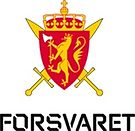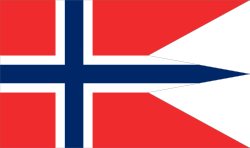- Norwegian Armed Forces
-
Norwegian Armed Forces
Forsvaret
Service branches Army
Navy (Coast Guard)
Air Force
Home GuardLeadership Commander-in-Chief King Harald V Minister of Defense Grete Faremo Chief of staff General Harald Sunde Manpower Military age 18-44(55) years of age for male compulsory military service (55 years of age if you are an officer); 16 years of age in wartime; 17 years of age for male volunteers; 18 years of age for women Conscription 19-month service with 12-month service obligation. Around 50% of conscripts are enrolled in the Home Guard, for a 7 month period (spread out over many years). Available for
military service1,078,181 males, age 16-55 (2008 est.),
1,046,550 females, age 16-55 (2008 est.)Fit for
military service888,219 males, age 16-55 (2008 est.),
863,255 females, age 16-55 (2008 est.)Reaching military
age annually31,980 males (2008 est.),
30,543 females (2008 est.)Active personnel 26,200 [1] Expenditures Budget $6.2 billion (2009)[1] Percent of GDP 1.6% of GDP (2009 est.) Related articles History World War II
Cold War
Congo Crisis
Gulf War
War in Kosovo
War in Afghanistan
Libyan no-fly zone
The Norwegian Armed Forces (Norwegian: Forsvaret ("The Defence")) numbers about 23,000 personnel, including civilian employees.[2] According to mobilisation plans as of 2009[update], the strength during full mobilisation would be approximately 83,000 combatant personnel.[2] Norway has mandatory military service for men (6–12 months of training) and voluntary service for women. Norway has the highest military expenditures per capita in Europe.
The Armed Forces sorts under the Norwegian Ministry of Defence. The formal Commander-in-chief is H.M. King Harald V. However, the Chief of Defense (Norwegian "Forsvarssjefen") is the de facto Commander-in-chief.
Under Norwegian constitutional practice, the Minister of Defence is accountable to Parliament for all activities carried out by the agencies under his or her responsibility.
The Ministry of Defence (MoD) has been since 2003 an integrated structure with civilian and military personnel. Subordinate to the MoD are the "Armed Forces Military Organisation" as well as the three civilian agencies: the Norwegian Defence Research Establishment (FFI), the National Security Agency and the Defence Estate Agency.
The main annual national exercise is Cold Response, held yearly, with all NATO member states invited.
Contents
Organisation
The Chief of Defence (a four-star general or admiral) heads the armed forces, and is the principal military adviser to the Minister of Defence.
Military branches (in order of seniority):
Other main structures, include:
- Special forces
- Defence Staff Norway (DEFSTNOR) in Oslo acts as the staff of the Chief of Defence. It is headed by a three star general or admiral. DEFSTNOR assigns priorities, manages resources, provides force generation and support activities. Each of the four branches of defence is headed by a two star general/admiral who are subordinate to DEFSTNOR.
- National Joint Headquarters (NJHQ) located at Reitan, close to Bodø has operational control of Norwegian armed forces worldwide 24/7. It is headed by the Supreme Commander Norwegian Forces - a three star general or admiral.
- Norwegian Defence Logistics Organisation (NDLO) at Kolsås outside Oslo is responsible for engineering, procurement, investment, supply, information and communications technology. It is also responsible for maintenance, repair and storage of material.
Structure
Joint
- 1 National Joint Headquarters in Bodø
- 12 Home Guard districts
- Tactical Mobile Land/Maritime Command
- Special forces
- FSK (Forsvarets spesialkommando) (the equivalent to the UK Special Air Service, the US Delta Force or the Canadian JTF2).
-
- HJK (Hærens Jegerkommando)
- MJK (Marinejegerkommandoen) ( the equivalent to the US Navy Seals or the UK Special Boat Service).
- 1 Air Wing, 720Sqn (has been relived of its special forces duties, and now work on medical evacuations).
- Joint ISTAR Unit (Intelligence, Surveillance, Target Acquisition and Reconnaissance)
- Module based ISTAR Unit
- Norwegian Coastal Ranger Command (Kystjegerkommandoen in Norwegian)
- Unmanned aerial vehicle capability
- Airborne Ground Surveillance (joint NATO project)
- Norwegian Home Guard - 50,000 personnel + 33,000 (reserve), rapid reaction forces, follow-on-forces, reinforcement forces and reserves.
- Capacity for information operations
- Norwegian Defence Security Department (NORDSD)
- Flexible medical units
- NRBC protection (Nuclear, radiological, biological, chemical weapons )
- Explosive Ordnance Disposal
- Joint C2I Unit (command, control and information)
- Civil Military Coordination Unit (CIMIC)
- Deployable logistical support
- 2 mobilisation host country battalions (logistics for allied reinforcements)
Norwegian Army
With August 1, 2009 the Norwegian Army changed its structure:[3][4]
- Brigade Nord (operational units)
- Norwegian Army Special Forces Command
- Army Weapons School
- HM the Kings Guard
- Garnisonen i Sør-Varanger
- Military Academy
- Logistics and Operational Support
- Operation Support Detachment
- Home Guard (Land)
- 5 Fridtjof Nansen class Aegis frigates - four fully operational as of August 2010[citation needed]
- 6 Skjold class fast patrol boats - - None operational as of September 2009[citation needed]
- 6 Ula class submarines
- Mine Warfare Capability
- 6 (8) Oksøy class mine hunter and Alta class mine sweeper
- Mine Clearance Command (divers); HNoMS Tyr support vessel
- Norwegian Coastal Ranger Command
- Naval Ranger Command
- Tactical Naval Command
- Logistics/Support Capacity
- Home Guard (Sea)
- Coast Guard
- 1 Svalbard class vessel
- 3 Barentshav class vessels
- 3 Nordkapp class OPV
- Leased vessels (KV Tromsø and KV Ålesund, KV Harstad, 6 ocean patrol vessels)
- Inner coast guard (25 leased vessels)
- Tug capacity
- Strategic Sealift
- Home Guard (Sea) (235 patrol and Tug vessels)
Royal Norwegian Air Force
- 72 + 2(1987) F-16 Fighting Falcon about 50-60 operational.
- 2 Air Control Centre/Recognized Air picture Production Centre/Sensor Fusion post (ARS Sørreisa and ARS Mågerø)
- Strategic Airlift / Aerial refueling (common NATO projects)
- Maritime surveillance (4 x P-3C Orion and 2 x P-3N Orion)
- Electronic Warfare (2 + 1 DA-20 Jet Falcon)
- Transport 4x C-130J Super Hercules
- Air Defence Artillery (NASAMS)
- Air Wing for Special Forces (6 x Bell 412)
- Home Guard (Air)
- 18 Bell 412 transport and light attack helicopters
- 6 NH-90 maritime helicopters (frigates)
- 4 Westland Lynx Special Operations and maritime helicopters (Norwegian Coast Guard)
- Deployable base support
- 12 Sea King search and rescue helicopters
Small arms and handguns
- Heckler & Koch MP5 - being replaced by MP7.
- Heckler & Koch MP7
- Heckler & Koch HK416 - standard assault rifle.
- Heckler & Koch HK417
- Heckler & Koch G36 - Special forces only, to be replaced by the HK416
- Colt Canada C7 rifle - Special forces only, to be replaced by the HK416
- Colt Canada C8 rifle - Special forces only, to be replaced by the HK416
- AG3 - former standard assault rifle. currently used by parts of the Home Guard
- Barrett M82
- Glock 17 - to be replaced by the MP7 in some areas.
- Rheinmetall MG3
- M72 LAW - Light anti-armour weapon
- Carl Gustav recoilless rifle - Anti-armour weapon
- FGM-148 Javelin - Anti-armour guided missile [5]
References
- ^ Defence Expenditures of NATO Countries (1985-2009)
- ^ a b "NDF official numbers". NDF. http://www.mil.no/languages/english/start/facts/article.jhtml?articleID=32061. Retrieved 2007-07-16.
- ^ http://www.mil.no/multimedia/archive/00136/0560_H_R_Poster_592_136082a.pdf
- ^ http://www.mil.no/multimedia/archive/00136/0560_H_rbrosjyren_N_136081a.pdf
- ^ "Perfecting the Javelin simulator - the new anti-armor weapon is being phased in this year". Hærens Styrker. 17 March 2009. http://www.mil.no/haren/start/article.jhtml?articleID=175413. Retrieved 17 June 2009.
External links
- Royal Norwegian Ministry of Defence
- Norwegian Defence Force
- One for all, all for one? New Nordic Defence Partnership? Publication from the Nordic Council of Ministers. Free download.
Norwegian Armed Forces Branches 
Equipment Organisation Related North Atlantic Treaty Organization (NATO) History 
Structure Members Military of Europe Sovereign
states- Albania
- Andorra
- Armenia
- Austria
- Azerbaijan
- Belarus
- Belgium
- Bosnia and Herzegovina
- Bulgaria
- Croatia
- Cyprus
- Czech Republic
- Denmark
- Estonia
- Finland
- France
- Georgia
- Germany
- Greece
- Hungary
- Iceland
- Ireland
- Italy
- Kazakhstan
- Latvia
- Liechtenstein
- Lithuania
- Luxembourg
- Macedonia
- Malta
- Moldova
- Monaco
- Montenegro
- Netherlands
- Norway
- Poland
- Portugal
- Romania
- Russia
- San Marino
- Serbia
- Slovakia
- Slovenia
- Spain
- Sweden
- Switzerland
- Turkey
- Ukraine
- United Kingdom
- Vatican City
States with limited
recognition- Abkhazia
- Kosovo
- Nagorno-Karabakh
- Northern Cyprus
- South Ossetia
- Transnistria
Other entities - European Union
- Sovereign Military Order of Malta
Categories:- Weapons of Norway
- Military of Norway
- Conscript militaries
Wikimedia Foundation. 2010.


